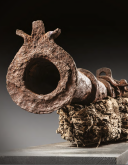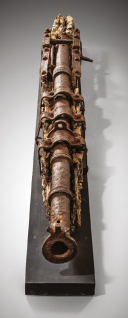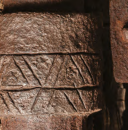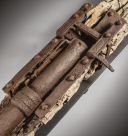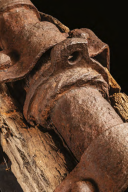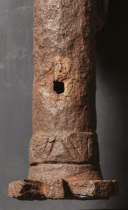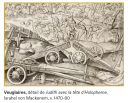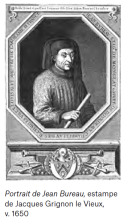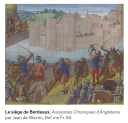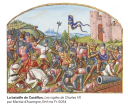
Veuglaire on its carriage France (found in Dordogne), mid-15th century. Public auction : TENTATION° 3 Thursday, May 22, 2025 - 6 p.m Drouot - room 9: Giquello et associés
TEMPTATION° 3
Thursday, May 22, 2025 - 6pm
Drouot - Room 9
EXHIBITION
Tuesday, May 20 and Wednesday, May 21, from 11am to 6pm
and Thursday, May 22, from 11am to 4pm
Phone during the exhibition +33(0) 1 48 00 20 09
GIQUELLO
Alexandre Giquello
Violette Stcherbatcheff
5, rue La Boétie - 75008 Paris
+33 (0)1 47 42 78 01 - info@giquello.net
o.v.v. approval no. 2002 389
CONTACT
Arthur Calcet
+33 (0)6 85 91 45 64
a.calcet@giquello.net
SPECIALIST
Marina Viallon
EXPERT
Bertrand Malvaux, CNES
Estimate: 20,000 : 40,000 euros
LOT 4
Veuglaire on its carriage
France (found in Dordogne), mid-15th century
Iron, wood, gunpowder (likely)
Exceptional wrought iron veuglaire, complete, still attached to its upper wooden carriage. This veuglaire, a medieval artillery piece loaded through the breech, is composed of a very long barrel made of two welded half-tubes held together by five rings, a mouthpiece, and a wide breech slice. At the rear of the breech, there is a removable powder box with a large handle, pierced with a hole at the top for ignition and equipped at the back with a half-protruding border to lock under the clamping wedge. Today stuck in the barrel by rust, it is highly probable that the inside of this box still retains a large amount of gunpowder it was filled with. At the front of the barrel, the mouthpiece, engraved with parallel lines, is equipped with a sighting button cut in the shape of flames or a fleur-de-lis, aligned with a large sighting hole placed on the central ring, itself framed by two decorative twisted circles. The other intermediate circles are simply adorned with engraved lines. The mouth belt is decorated with a series of roughly executed chevrons, also found in two registers on the breech band. On the latter, placed between the chevrons of one of the decorated bands, a heraldic punch has been struck between each ornamental chevron. One can distinguish a shield bearing a chevron surrounded by three roundels.
The veuglaire itself is presented resting on its original upper carriage, a pointed oak plank tapering towards the rear and stopping about twenty centimeters before the mouth of the piece. The tube is fixed to the carriage with three large iron bands held by large round-headed nails for the upper ones, flattened for the side ones. For land transport and maneuvers, this upper carriage was placed and hinged on another wooden piece with two wheels. The pointed part at the rear of the preserved upper piece allows, using a sort of rack, to incline the veuglaire more or less relative to the lower carriage, and thus adjust the firing angle.
At the rear of the veuglaire, the entire powder box retention system is preserved. This box is framed by two large iron bands fixed to the top of the carriage by large round-headed nails, partly adorned with the same bands of engraved chevrons as on the veuglaire. These bands are perpendicular reinforced by another square ring nailed around the carriage at the back of the box (adorned with the same chevrons on the upper part), and two lateral braces a bit more forward (the one on the left is missing). Between the rear ring and the box, the large triangular iron clamping wedge used to securely hold the box against the tube is still in place. This wedge is pierced with a hole through which a strap connected to the carriage passed to prevent it from being lost, and its two ends retain the hammer blows deformations used to wedge it behind the box and remove it after firing. At the back of this device, a large flared plate fixed by three nails (one missing) protects the wood of the carriage from the pressure of the clamping wedge during firings.
The armorial bearings stamped on the carriage, as they appear to us, are unfortunately not attributable. However, considering their rather crude execution, it is not impossible that they represent here a simplified version of the arms of Jean Bureau, artillery commissioner of Charles VII for the Guyenne campaign alongside his brother Gaspard, himself master of artillery (azure a chevron potent counter-potent or filled with sand, accompanied by three roundels/pattées of gold). The roundels or pattées being vessels with a very bulging belly, they could indeed have been reduced to these three circles here. A direct association with Jean Bureau would correspond with the exceptionally developed decoration of this veuglaire, whose possible fleur-de-lis on the sighting button could refer to the French royal arms.
To this day, this is the only wrought iron veuglaire preserved with such ornamental richness, the pattern of the decorative bands also appears to recall the chevrons of the stamped armorial bearings. This piece, along with lots 5 and 6 of this present sale, are the only known artillery pieces to have been found within the "Castillon group."
Total H. 30 cm – Total L. 289 cm
L. of the tube (with the box) 206 cm – caliber 7 cm
Provenance:
- French private collection
- Transmitted by inheritance in 1988
Fair archaeological condition concerning the iron parts, fairly stable surface oxidation throughout despite some fragility in places. Holed barrel in its upper part at the front. Ring at the back of the clamping wedge of the box slightly loose due to the detachment of the nails, commonly held in place by a modern wire. The wood of the carriage, dried too quickly after being removed from the river, has strongly shrunk causing large cracks and completely pushing out some nails. It is currently quite fragile. Some accidents on the carriage, particularly at the front and in its middle part, are due to the mechanical handling of the piece during its discovery.
NOTE:
Three unique veuglaires from the Castillon group.
The veuglaire were medium-caliber artillery pieces with relatively long barrels launching small stone cannonballs, preferably used in the field or against the personnel of strongholds. To increase the rate of fire, veuglaires had the characteristic of having a removable powder chamber, called a box, which was fixed to the rear of the tube. Each piece thus had several associated boxes, to be able to chain loadings and increase their rate of fire. Mounted on wheeled carriages, veuglaires, ranging from small to large calibers, are highly mobile pieces and thus became, under Charles VII, the first type of field artillery. The development of a true artillery train within the French army is largely due to the innovations and administrative and technical reforms of the brothers Jean and Gaspard Bureau, about whom the chroniclers of the time heap praise, and who led the royal artillery during the Guyenne campaign of 1453.
At Castillon, on July 17, 1453, according to the chronicles, nearly 300 artillery pieces (all sizes and types combined) defended the fortified camp of the French set up by Bureau. Responsible for many human losses on the English side, this artillery was the key element of the French victory that day. In the mid-15th century, this medium-caliber artillery is the weapon of the moment, especially in pitched battles. Associated with new tactics, it won many battles against the English and hastened the outcome of the Hundred Years' War in favor of the French.
Discovered deep in the Dordogne among the swords of the famous "Castillon group," these three pieces could be the only surviving examples of the royal artillery of Charles VII, used at Castillon and during the rest of the campaign to reconquer English Guyenne.
Illustrations published:
— Portrait of Jean Bureau, engraving by Jacques Grignon the Elder, c.1650
— Veuglaires, detail of Judith with the head of Holofernes, Israhel von Mackenem, c.1470-80
— The siege of Bordeaux, Old Chronicles of England by Jean de Wavrin, BnF ms Fr. 84
— The Battle of Castillon, The Vigils of Charles VII by Martial d'Auvergne, BnF ms Fr. 5054
HISTORY:
The "Castillon group"
In the early 1970s, a chance discovery during dredging in the Dordogne revealed a significant collection of 15th-century weapons, in excellent state of preservation, likely from a sunken vessel. Dispersed on the market over the years by its discoverers, the group was previously only known for its exceptional lot of swords (probably around a hundred) and some daggers. The present sale now allows the attachment of three exceptional artillery pieces to it. Based on various, sometimes evasive and contradictory, information gathered over the years, it had been concluded that the discovery was made in the immediate vicinity of the town of Castillon-la-Bataille.
The dating of the swords and their quantity naturally led specialists to associate these items with the famous French victory of 1453 that ended the Hundred Years' War. Perhaps these were weapons reclaimed as booty on the battlefield? More recent information, however, revealed that the objects were actually found further downstream on the Dordogne, not far from the Ambès point, formed by the confluence with the Garonne. This new piece of information, along with the connection to the group of three veuglaires presented here, provides new insights into this exceptional ensemble. While their association with the Battle of Castillon remains a strong possibility, their presence near the mouth of the Dordogne can shed light on their potential destination.
Following his decisive victory over the Anglo-Gascon troops of John Talbot on July 17, 1453, Charles VII's army continued its progression downstream along the Dordogne, retaking one after another cities and fortresses offering little resistance, heading towards Bordeaux, the capital of Guyenne still in English possession. Mastering the Dordogne, Charles VII and his troops settled around the castle of Montferrand, on the Ambès point, and besieged Bordeaux on August 13. With the surrender of the city on October 19, the Guyenne region definitively returned to French control, and the Hundred Years' War came to an end. The weapons of the "Castillon group" could have perfectly constituted the cargo of a French army vessel, coming from Castillon or one of the fortresses retaken along the way, and bound for Charles VII's camp preparing to besiege Bordeaux. In any case, they represent exceptional historical and technical testimonies of military arts in France in the mid-15th century.
Thursday, May 22, 2025 - 6pm
Drouot - Room 9
EXHIBITION
Tuesday, May 20 and Wednesday, May 21, from 11am to 6pm
and Thursday, May 22, from 11am to 4pm
Phone during the exhibition +33(0) 1 48 00 20 09
GIQUELLO
Alexandre Giquello
Violette Stcherbatcheff
5, rue La Boétie - 75008 Paris
+33 (0)1 47 42 78 01 - info@giquello.net
o.v.v. approval no. 2002 389
CONTACT
Arthur Calcet
+33 (0)6 85 91 45 64
a.calcet@giquello.net
SPECIALIST
Marina Viallon
EXPERT
Bertrand Malvaux, CNES
Estimate: 20,000 : 40,000 euros
LOT 4
Veuglaire on its carriage
France (found in Dordogne), mid-15th century
Iron, wood, gunpowder (likely)
Exceptional wrought iron veuglaire, complete, still attached to its upper wooden carriage. This veuglaire, a medieval artillery piece loaded through the breech, is composed of a very long barrel made of two welded half-tubes held together by five rings, a mouthpiece, and a wide breech slice. At the rear of the breech, there is a removable powder box with a large handle, pierced with a hole at the top for ignition and equipped at the back with a half-protruding border to lock under the clamping wedge. Today stuck in the barrel by rust, it is highly probable that the inside of this box still retains a large amount of gunpowder it was filled with. At the front of the barrel, the mouthpiece, engraved with parallel lines, is equipped with a sighting button cut in the shape of flames or a fleur-de-lis, aligned with a large sighting hole placed on the central ring, itself framed by two decorative twisted circles. The other intermediate circles are simply adorned with engraved lines. The mouth belt is decorated with a series of roughly executed chevrons, also found in two registers on the breech band. On the latter, placed between the chevrons of one of the decorated bands, a heraldic punch has been struck between each ornamental chevron. One can distinguish a shield bearing a chevron surrounded by three roundels.
The veuglaire itself is presented resting on its original upper carriage, a pointed oak plank tapering towards the rear and stopping about twenty centimeters before the mouth of the piece. The tube is fixed to the carriage with three large iron bands held by large round-headed nails for the upper ones, flattened for the side ones. For land transport and maneuvers, this upper carriage was placed and hinged on another wooden piece with two wheels. The pointed part at the rear of the preserved upper piece allows, using a sort of rack, to incline the veuglaire more or less relative to the lower carriage, and thus adjust the firing angle.
At the rear of the veuglaire, the entire powder box retention system is preserved. This box is framed by two large iron bands fixed to the top of the carriage by large round-headed nails, partly adorned with the same bands of engraved chevrons as on the veuglaire. These bands are perpendicular reinforced by another square ring nailed around the carriage at the back of the box (adorned with the same chevrons on the upper part), and two lateral braces a bit more forward (the one on the left is missing). Between the rear ring and the box, the large triangular iron clamping wedge used to securely hold the box against the tube is still in place. This wedge is pierced with a hole through which a strap connected to the carriage passed to prevent it from being lost, and its two ends retain the hammer blows deformations used to wedge it behind the box and remove it after firing. At the back of this device, a large flared plate fixed by three nails (one missing) protects the wood of the carriage from the pressure of the clamping wedge during firings.
The armorial bearings stamped on the carriage, as they appear to us, are unfortunately not attributable. However, considering their rather crude execution, it is not impossible that they represent here a simplified version of the arms of Jean Bureau, artillery commissioner of Charles VII for the Guyenne campaign alongside his brother Gaspard, himself master of artillery (azure a chevron potent counter-potent or filled with sand, accompanied by three roundels/pattées of gold). The roundels or pattées being vessels with a very bulging belly, they could indeed have been reduced to these three circles here. A direct association with Jean Bureau would correspond with the exceptionally developed decoration of this veuglaire, whose possible fleur-de-lis on the sighting button could refer to the French royal arms.
To this day, this is the only wrought iron veuglaire preserved with such ornamental richness, the pattern of the decorative bands also appears to recall the chevrons of the stamped armorial bearings. This piece, along with lots 5 and 6 of this present sale, are the only known artillery pieces to have been found within the "Castillon group."
Total H. 30 cm – Total L. 289 cm
L. of the tube (with the box) 206 cm – caliber 7 cm
Provenance:
- French private collection
- Transmitted by inheritance in 1988
Fair archaeological condition concerning the iron parts, fairly stable surface oxidation throughout despite some fragility in places. Holed barrel in its upper part at the front. Ring at the back of the clamping wedge of the box slightly loose due to the detachment of the nails, commonly held in place by a modern wire. The wood of the carriage, dried too quickly after being removed from the river, has strongly shrunk causing large cracks and completely pushing out some nails. It is currently quite fragile. Some accidents on the carriage, particularly at the front and in its middle part, are due to the mechanical handling of the piece during its discovery.
NOTE:
Three unique veuglaires from the Castillon group.
The veuglaire were medium-caliber artillery pieces with relatively long barrels launching small stone cannonballs, preferably used in the field or against the personnel of strongholds. To increase the rate of fire, veuglaires had the characteristic of having a removable powder chamber, called a box, which was fixed to the rear of the tube. Each piece thus had several associated boxes, to be able to chain loadings and increase their rate of fire. Mounted on wheeled carriages, veuglaires, ranging from small to large calibers, are highly mobile pieces and thus became, under Charles VII, the first type of field artillery. The development of a true artillery train within the French army is largely due to the innovations and administrative and technical reforms of the brothers Jean and Gaspard Bureau, about whom the chroniclers of the time heap praise, and who led the royal artillery during the Guyenne campaign of 1453.
At Castillon, on July 17, 1453, according to the chronicles, nearly 300 artillery pieces (all sizes and types combined) defended the fortified camp of the French set up by Bureau. Responsible for many human losses on the English side, this artillery was the key element of the French victory that day. In the mid-15th century, this medium-caliber artillery is the weapon of the moment, especially in pitched battles. Associated with new tactics, it won many battles against the English and hastened the outcome of the Hundred Years' War in favor of the French.
Discovered deep in the Dordogne among the swords of the famous "Castillon group," these three pieces could be the only surviving examples of the royal artillery of Charles VII, used at Castillon and during the rest of the campaign to reconquer English Guyenne.
Illustrations published:
— Portrait of Jean Bureau, engraving by Jacques Grignon the Elder, c.1650
— Veuglaires, detail of Judith with the head of Holofernes, Israhel von Mackenem, c.1470-80
— The siege of Bordeaux, Old Chronicles of England by Jean de Wavrin, BnF ms Fr. 84
— The Battle of Castillon, The Vigils of Charles VII by Martial d'Auvergne, BnF ms Fr. 5054
HISTORY:
The "Castillon group"
In the early 1970s, a chance discovery during dredging in the Dordogne revealed a significant collection of 15th-century weapons, in excellent state of preservation, likely from a sunken vessel. Dispersed on the market over the years by its discoverers, the group was previously only known for its exceptional lot of swords (probably around a hundred) and some daggers. The present sale now allows the attachment of three exceptional artillery pieces to it. Based on various, sometimes evasive and contradictory, information gathered over the years, it had been concluded that the discovery was made in the immediate vicinity of the town of Castillon-la-Bataille.
The dating of the swords and their quantity naturally led specialists to associate these items with the famous French victory of 1453 that ended the Hundred Years' War. Perhaps these were weapons reclaimed as booty on the battlefield? More recent information, however, revealed that the objects were actually found further downstream on the Dordogne, not far from the Ambès point, formed by the confluence with the Garonne. This new piece of information, along with the connection to the group of three veuglaires presented here, provides new insights into this exceptional ensemble. While their association with the Battle of Castillon remains a strong possibility, their presence near the mouth of the Dordogne can shed light on their potential destination.
Following his decisive victory over the Anglo-Gascon troops of John Talbot on July 17, 1453, Charles VII's army continued its progression downstream along the Dordogne, retaking one after another cities and fortresses offering little resistance, heading towards Bordeaux, the capital of Guyenne still in English possession. Mastering the Dordogne, Charles VII and his troops settled around the castle of Montferrand, on the Ambès point, and besieged Bordeaux on August 13. With the surrender of the city on October 19, the Guyenne region definitively returned to French control, and the Hundred Years' War came to an end. The weapons of the "Castillon group" could have perfectly constituted the cargo of a French army vessel, coming from Castillon or one of the fortresses retaken along the way, and bound for Charles VII's camp preparing to besiege Bordeaux. In any case, they represent exceptional historical and technical testimonies of military arts in France in the mid-15th century.
Reference :
Giquello et associés
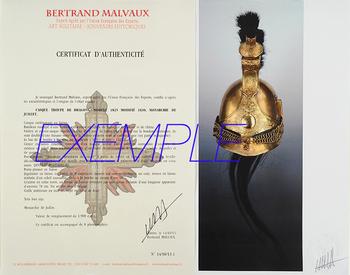
Next update Friday, december 12 at 13:30 PM
FOR ALL PURCHASES, PAYMENT IN MULTIPLE CHECKS POSSIBLE
bertrand.malvaux@wanadoo.fr 06 07 75 74 63
SHIPPING COSTS
Shipping costs are calculated only once per order for one or more items, all shipments are sent via registered mail, as this is the only way to have proof of dispatch and receipt.
For parcels whose value cannot be insured by the Post, shipments are entrusted to DHL or Fedex with real value insured, the service is of high quality but the cost is higher.
RETURN POLICY
Items can be returned within 8 days of receipt. They must be returned by registered mail at the sender's expense, in their original packaging, and in their original condition.
AUTHENTICITY
The selection of items offered on this site allows me to guarantee the authenticity of each piece described here, all items offered are guaranteed to be period and authentic, unless otherwise noted or restricted in the description.
An authenticity certificate of the item including the description published on the site, the period, the sale price, accompanied by one or more color photographs is automatically provided for any item priced over 130 euros. Below this price, each certificate is charged 5 euros.
Only items sold by me are subject to an authenticity certificate, I do not provide any expert reports for items sold by third parties (colleagues or collectors).
FOR ALL PURCHASES, PAYMENT IN MULTIPLE CHECKS POSSIBLE
bertrand.malvaux@wanadoo.fr 06 07 75 74 63
An authenticity certificate of the item including the description published on the site, the period, the sale price, accompanied by one or more color photographs is automatically provided for any item priced over 130 euros. Below this price, each certificate is charged 5 euros.
Only items sold by me are subject to an authenticity certificate, I do not provide any expert reports for items sold by third parties (colleagues or collectors).
